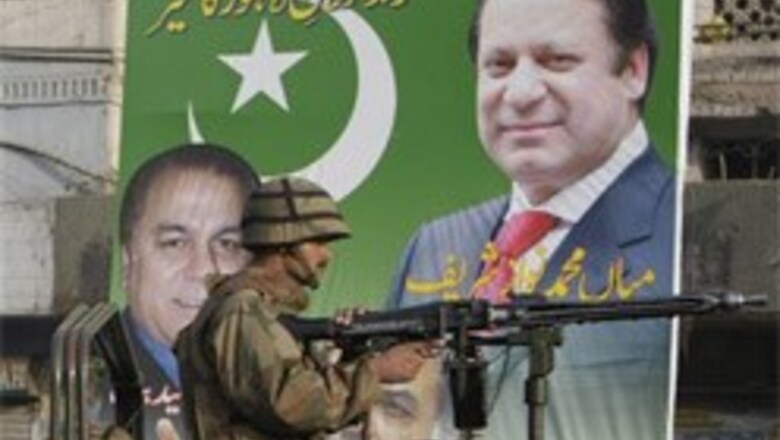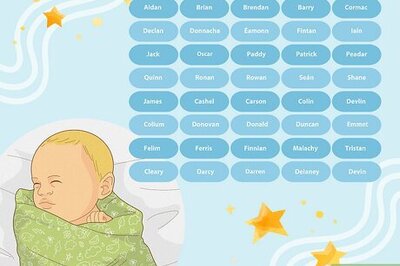
views
More than 80 million Pakistanis aged 18 or over are eligible to vote Monday. More than 60,000 polling stations will open at 10 pm (EST) on Sunday and close at 7 am (EST) on Monday.
Early results are expected in the early afternoon but final official figures may not be available until Wednesday. In recent decades, turnout has been modest, running about 40 per cent in the last national elections in 2002.
What's at Stake:
Voters will choose 272 members of the National Assembly, or lower house of parliament, for a five-year term. Another 60 seats are reserved for women and 10 for religious minorities.
Those seats are distributed among parties based on how they fare in the election. Once the new parliament convenes, President Pervez Musharraf, who was re-elected last October, asks the party winning the most lower house seats to nominate a prime minister, subject to majority vote in the legislature. Voters will also choose legislatures in each of the country's four provinces.
Key Issues:
The election is widely seen as a full restoration of civilian government after eight years of military rule under Musharraf, who seized power in a 1999 military coup.
The new parliament will also have to confront major issues such as growing Islamic militancy, a sluggish economy and whether to reinstate independent-minded judges who were removed by Musharraf during a state of emergency he declared in November. If the opposition wins more than two-thirds of the seats, it is likely to try to impeach the president.
NEXT: POLL TRIVIA
PAGE_BREAK
Poll trivia
> The National Assembly of Pakistan has 342 seats.
> Out of 342, 272 are general seats, 60 seats are reserved for women while 10 seats are reserved for non-Muslim communities.
> Out of the 272 general seats, Punjab has the biggest share with 148 seats, Sindh has 61 seats, the North-West Frontier Province (NWFP) has 35 seats, and Balochistan has 14 seats, with 12 seats going to the FATA and two to the federal capital.
> Punjab also has maximum voters numbering 44.9 million. Sindh has 19.5 million registered voters, NWFP has 11 million and Balochistan has just a little more than 4.3 million registered voters.
> About 81 million voters will exercise their franchise at 60,000 polling booths.
> Election will not be held on four seats including Larkana's district number 207, because of PPP chairperson Benazir Bhutto's death
> A record number of troops, 80,000 in all and thousands of other security personnel have been deployed across the country.
> None of the three biggest names in Pakistani politics is running for office in Monday's election, but they nonetheless are the key figures who will shape the postelection landscape:
> 253 lawyers are in the fray for the polls to the national and provincial assemblies.
> While a majority of the black coats are contesting as independents, 112 lawyers are fighting on tickets issued by various political parties.
> Pakistan has seen six general elections in the past 22 years in 1985, 1988, 1990, 1993, 1997 and 2002.
> The President of Pakistan appoints a Chief Election Commissioner who heads the Election Commission.
> The EC is an independent and autonomous constitutional body responsible for conducting free, fair and transparent elections.
NEXT: KEY FACTS ABOUT PAKISTAN
PAGE_BREAK
Key facts about Pakistan
Population: 160 million, out of which 97 per cent are Muslim, with the rest Christian, Hindu and Sikh minorities. Main ethnic groups are Punjabis, Pashtuns, Sindhis, Baluch and Mohajirs. All the ethnic groups speak different languages but Urdu is the national language.
Location: Pakistan borders Iran, Afghanistan, India, China and 650 miles of the Arabian Sea. Its area is 300,664 square miles.
Independence: It was British-ruled until 1947 when the subcontinent was split into India and Pakistan.
Economy: Largely agricultural. Chief products are wheat, cotton, rice, sugarcane and maize. Major exports are textiles, rice and surgical instruments. Per capita GDP is $2,600. The economy grew by 6.6 per cent during 2007.
Governance: Pakistan has been ruled by army generals for over half of its 60-year history. Although a parliamentary democracy, elected governments have been unstable and vulnerable to military intervention.
The strategic picture: Pakistan and India have fought three wars. Tensions have eased in recent years although they are little closer to resolving their territorial dispute over Kashmir. Both India and Pakistan have nuclear weapons.
(Source: Election Commission of Pakistan and Associated Press)




















Comments
0 comment